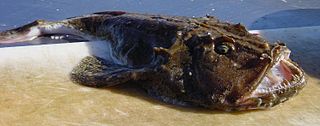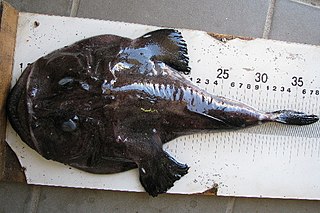
Goosefishes, sometimes called anglers or monkfishes, are a family, the Lophiidae, of marine ray-finned fishes belonging to the order Lophiiformes, the anglerfishes. These fishes are found in all the world's oceans except for the Antarctic Ocean.

Lophius piscatorius, commonly known as the angler, European angler or common monkfish, is a monkfish in the family Lophiidae. It is found in coastal waters of the northeast Atlantic, from the Barents Sea to the Strait of Gibraltar, the Mediterranean and the Black Sea. Within some of its range, including the Irish Sea, this species comprises a significant commercial fishery.

Members of the genus Lophius, also sometimes called monkfish, fishing-frogs, frog-fish, and sea-devils, are various species of lophiid anglerfishes found in the Atlantic and Indian Oceans. Lophius is known as the "monk" or "monkfish" to the North Sea and North Atlantic fishermen, a name which also belongs to Squatina squatina, the angelshark, a type of shark. The North European species is Lophius piscatorius, and the Mediterranean species is Lophius budegassa.

The sea toads and coffinfishes are a family of deep-sea anglerfishes known as the Chaunacidae.

Double anglers are a family, Diceratiidae, of anglerfishes. They are found in deep, lightless waters of the Atlantic, Indian and western Pacific Oceans.

Lophius americanus is a goosefish in the family Lophiidae, also called all-mouth, American anglerfish, American monkfish, bellows-fish, devil-fish, headfish, molligut, satchel-mouth, or wide-gape. It is native to the eastern coast of North America.
Lophichthys boschmai, also known as Arafura frogfish or Boschma's frogfish, is a species of anglerfishes closely related to frogfish. L. boschmai is the only species in the Lophichthydae family. L. boschmai were first reported by Marinus Boseman in 1964 to the Rijksmuseum van Natuurlijke Historie, now known as National Museum of Natural History in Leiden. The species was named after Dutch zoologist, Hildbrand Boschma.

The anglerfish are fish of the teleost order Lophiiformes. They are bony fish named for their characteristic mode of predation, in which a modified luminescent fin ray acts as a lure for other fish. The luminescence comes from symbiotic bacteria, which are thought to be acquired from seawater, that dwell in and around the sea.

Chaunax is a genus of bony fish in the sea toad family Chaunacidae. They are found in tropical and subtropical oceans around the world and most species are found at depths between 180 and 1,100 m, but C. endeavouri occurs as shallow as 50 m (160 ft) and C. fimbriatus as deep as 1,985 m (6,512 ft). Depending on the exact species involved, they reach a total length of 11–40 cm (4.3–15.7 in).
Lophiomus is a monospecific genus of marine ray-finned fish belonging to the family, Lophiidae, the goose fishes, monkfishes or anglers. The only species in the genus is Lophiomus setigerus, the blackmouth angler, blackmouth goosefish, broadheaded angler or broadhead goosefish. This fish is found in the Indo-Pacific.

Sladenia is a genus of marine ray-finned fishes belonging to the family Lophiidae, which includes the goosefishes, monkfishes and anglers. These are deepwater anglers found in theIndian Ocean, the Caribbean Sea and the Western Pacific Ocean.

The coffinfish or furry coffinfish is a species of sea toad of the family Chaunacidae. It is found in salty temperate waters of southwestern Pacific, off east coast of Australia. The coffinfish was first discovered around February 1997 in Sicily, Italy by the skipper of the Libra, which was a trawler who was harbored in Mazara at the time. It can be also found in depths of 50–300 m (164–984.3 ft). Deep sea crab fishermen off the east coast of Florida pull them up from depth ranging from 5,000–8,000 feet about 54–68 miles off the coast. They have a globose and spiny body that grows to a maximum length of 22.0 cm (8.7 in) and a black mouth lining and an illicium on the snout that can be lowered into a groove.

Caruso brachysomus is an extinct species of ray-finned fish belonging to the family Lophiidae, the goosefishes, monkfishes and anglers, within the order Lophiiformes, the anglerfishes. It was described by Louis Agassiz in 1835 from the Monte Bolca locality. It became extinct during the middle Eocene.

Lophius budegassa, the blackbellied angler or blackbellied monkfish, is a species of marine ray-finned fish belonging to the family Lophiidae, the goosefishes, monkfishes and anglers. This species is found in the eastern Atlantic Ocean and the Mediterranean Sea.

Lophiodes beroe, the white goosefish or white anglerfish, is a species of marine ray-finned fish belonging to the family Lophiidae, the goosefishes, monkfishes or anglers. This species is found in deep waters in the western Atlantic Ocean.
Ogcocephalus porrectus, the rosy-lipped batfish, is endemic to Cocos Island off the Pacific coast of Costa Rica. Though members of Ogcocephalidae occur in tropical, warm waters in both the Western Atlantic and Eastern Pacific. Rosy-lipped batfish generally reside in shallow to deep water benthic zones with a bathymetric range of 35 – 150 m. The syntypic series was collected at 120 m on a rocky bottom. What makes this fish distinctive are its rosy red lips, specialized pectoral fins used for "walking", and an illicium used for attracting prey.

Lophius vomerinus, the devil anglerfish, Cape monk or Cape monkfish, is a species of marine ray-finned fish belonging to the family Lophiidae, the goosefishes, monkfishes or anglerfishes. This species is endemic to the waters of the southeastern Atlantic and southwestern Indian Oceans around Southern Africa.

Lophiodes mutilus, the smooth angler or smooth monkfish, is a species of marine ray-finned fish belonging to the family Lophiidae, the goosefishes, monkfishes and anglers. This species is found in the Indo-Pacific.

Sladenia gardineri, the Indian round angler, is a species of marine ray-finned fish belonging to the family Lophiidae, the goose fishes, monkfishes or anglers. This species is found in the Indo-Pacific.

The Celebes monkfish is a species of marine ray-finned fish belonging to the family Lophiidae, the goose fishes, monkfishes or anglers. This species is found in the Indo-Pacific.


















